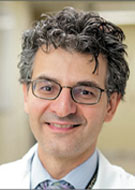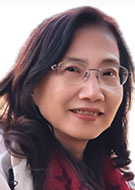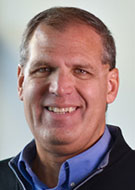Life After Leadership: Building a Foundation to Step Down
Building a future vision, providing mentorship and trusting in colleagues are a few ways to ease this inevitable transition



This is the third article in a three-part series about the experiences of radiologists in leadership. Read the first and second articles in the series.
For radiologists in leadership positions, a critical step is letting go—trusting the teams they’ve built and the legacy they’ve bestowed.
“There’s a point where we as radiologists will have more impact, and benefit radiology more, by stepping out than by staying in,” said Reed Omary, MD, MS, a tenured professor of radiology and biomedical engineering at Vanderbilt University School of Medicine in Nashville, TN.
For more than a decade, Dr. Omary served as Vanderbilt University Medical Center (VUMC)’s chair of radiology. In 2023 he took a sabbatical to explore a more (literally) global undertaking—examining sustainability in medicine and strategies to benefit patients, communities and the planet.
“I approached the process as a researcher does,” Dr. Omary said. “As scientists, if we want to study something, we collect data. And to do that we have to be good listeners.”
He interviewed hundreds of people from across the world, from CEOs to chefs, poets to politicians, and students to scientists, chronicling his experiences and observations on The Green Leap, an ever-growing platform of blog entries, videos and podcasts exploring health care systems’ impact on the environment.
What he learned helped lay the groundwork for Greenwell Project, a nonprofit with a mission to design sustainable medicine with patients at the center.
Meanwhile, at Vanderbilt, Dr. Omary was confident that he’d fostered an environment where upcoming leaders can thrive. As department chair, he established a $2 million endowment specifically for leadership development. He founded VUMC’s Medical Innovators Development Program, which trains candidates through a four-year curriculum centered on empathetic innovation.
“One of our roles as leaders is to build a pipeline of future leaders,” Dr. Omary said. “We don’t do this for ourselves; we do it for our departments. The whole point is the perpetuity, the legacy—building something that will outlive me. It’s the same approach when considering future generations and the planet.”

Mentoring Connections Outlast Professional Titles
For Wendy Wai Man Lam, MBBS, FRCR, letting go looks more like diversifying a portfolio.
A pediatric radiologist, Dr. Lam served as past president of both the Asian and Oceanic Society for Pediatric Radiology and the World Federation of Pediatric Imaging. From 2012 to 2018, she was chief of the radiology service at Queen Mary Hospital in Hong Kong, the teaching hospital of the University of Hong Kong, and as a radiology service director for Hong Kong West Cluster Hospitals.
Dr. Lam’s vision in medical imaging extends to exploring facets of humanity in images of her own creation. “Medical imaging and photography require many of the same skills—keen eyes, good observation and perseverance. Sometimes you need to wait a long time to get a good photo,” she said.
It also takes time to build up promising successors in the field. After leaving her position as chief, Dr. Lam stayed on at Queen Mary as a consultant to the department for some time. She found that giving up an official title didn’t fully mean leaving leadership behind.
She now divides her time across multiple public institutions in Hong Kong, serving as a pediatric radiology consultant in Hong Kong Children’s Hospital, starting her company to explore the use of AI for medical applications, and fulfilling a role that’s crucial to leadership: mentoring,
“My own mentors walked the walk, in both photography and medical imaging,” Dr. Lam said. “They both require one-to-one teaching, showing the trainee how to observe and report findings. As a mentor, I found that sharing my photos with trainees was a good way to improve communication and build relationships.”
Those one-on-one connections with trainees were what Garry Gold, MD, MS, was afraid he’d miss most.
Dr. Gold, who chaired the Department of Radiology at Stanford Medicine—first as interim chair following the death of Dr. Sanjiv “Sam” Gambhir in 2020, then as appointed chair beginning in 2022—had been living with a cardiac arrythmia since his 20s. Last year, despite multiple interventions, Dr. Gold’s health was worsening.
“I have three kids who are in their college years, and I was not able to work at my usual pace,” he said. “I decided, for the best interests of my family and the department, that I should step down.”
From the start, Dr. Gold understood that the position had a shelf life. “It’s a fiduciary role, a service to help the faculty and trainees succeed. I knew at some point I would want to return to my research, my teaching and my patient care duties, because that’s what drew me to the field in the beginning,” he said.
As he planned his transition, Dr. Gold was hit with the unexpected—and a reaffirmation of the value of preparing a legacy.
“Literally two days before I stepped down, I found myself in the hospital,” he recalled. “I thought I had got the flu, but it turned out I had bacterial sepsis.”

Trusting Colleagues to Take the Wheel
Through his extended hospitalization and multiple surgeries, Dr. Gold’s colleagues visited his bedside, offering personal support and professional expertise. “Gloria Hwang, an interventional radiologist, would come visit me after her long workday, and go over my chart with me,” he said. “She did that just because she cared.”
“When you’re a leader who has to make tough choices, sometimes leadership can feel lonely,” Dr. Gold said. “But it was so gratifying that my colleagues rallied around me, and, more than as a department chair, they appreciated me as a person.”
Now back at work as a professor of radiology and biomedical imaging, Dr. Gold has occasion to advise Quynh-Thu Le, MD, who stepped in as interim chair in addition to her duties as chair of radiation oncology. “It was a really inspired choice; she’s an incredible leader,” Dr. Gold said.
He’s grateful to be there to offer historical context for the department’s ongoing initiatives, and he’s able to focus again on mentoring. Though a strong champion for promising trainees, Dr. Gold admits he’s had difficulty letting go of the influence his position might have on their career paths.
“I think, ‘If I had just been on that search committee, I could have advocated harder for this person,’” he said. “But we have to realize that these processes are in place to make sure that the system works fairly and doesn’t come under the influence of just one person.”
Trusting the process makes for a more equitable system, but Dr. Gold empathizes with the misgivings a leader may have when someone new takes up the mantle.
Approaching a leadership position with the recognition that it won’t be forever helps radiologists support and respect fresh perspectives, he said. “We’re very fortunate to work in a field that’s so impactful and dynamic. Having someone with a new emphasis—a different vision of the future—can be extremely valuable.”
For Dr. Gold, that future includes his work in human performance. “As chair, I did research into imaging and performance as part of my lab,” he said. “As I was stepping down, I established the Center for Advanced Imaging in Human Performance at Stanford in 2024 which was funded by philanthropy and works closely with the Wu-Tsai Human Performance Alliance. We study the biological underpinnings of performance including athletes and injury recovery across a person’s lifespan.”
“This work, along with my role as co-director of the Canary Center for Early Detection at Stanford, gives me an important direction to focus as a researcher studying precision health as envisioned by my mentor, Sam Gambhir,” Dr. Gold said.
For More Information
Access Dr. Omary’s blog The Green Leap.
Learn more about the Greenwell Project.
Explore Dr. Lam’s gallery.
Learn more about the Wu Tsai Human Performance Alliance.
Read previous RSNA News stories on radiology leadership: